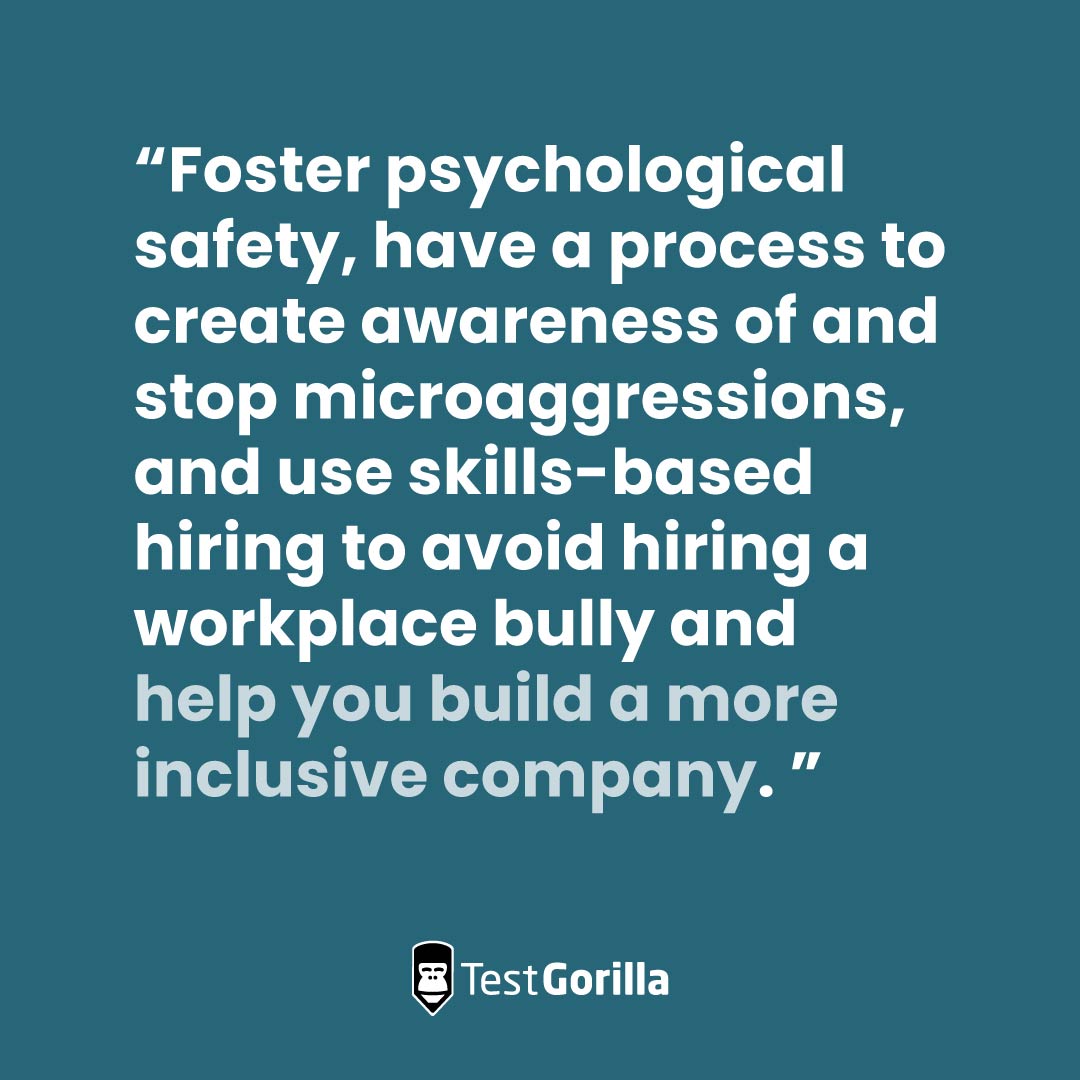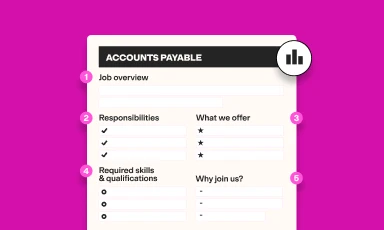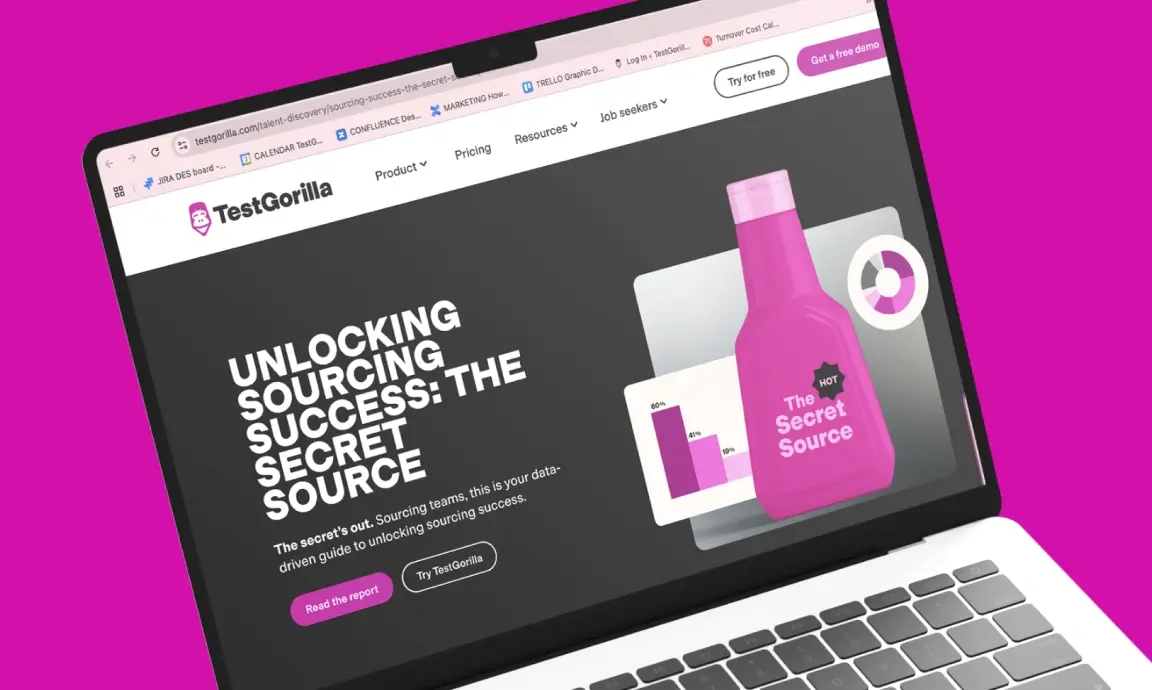From recruitment to retention: A skills-based approach to the employee lifecycle
Creating a diverse and inclusive workforce isn’t just a box-checking exercise or something to feel morally proud of. Diverse teams come up with better ideas to solve customers’ problems and make companies more innovative, productive, and profitable.[1]
The value businesses see in diversity is evidenced in the 91% of Fortune 500 companies that have now adopted nondiscrimination policies with gender identity protection.[2]
However, achieving true diversity and inclusion (D&I) goes beyond recruiting diverse candidates. To grow a team that embraces different perspectives and challenges outdated ways of working, you need to attract, hire, retain, and develop people equitably.
This article explores how skills-based hiring helps organizations prioritize people’s abilities, competencies, and potential throughout the recruitment process. It also covers how managers can use this tool to overcome unconscious bias and achieve better employee retention rates.
Lastly, we’ll look into how a skills-based approach helps managers make better decisions on who to promote and provide diverse workers with equal opportunities in professional development.
The link between skills-based hiring and D&I
D&I isn’t a nice-to-have – younger generations expect businesses to take these efforts seriously. In fact, 75% of Gen Z candidates would reconsider applying for a job if they believe the company isn’t diverse or inclusive.[3] However, investing in D&I is more than just a question of responding to these concerns, it’s also about getting better business results.
“Our workforce needs to reflect our consumers so we can serve them better,” says Andrea Mirabal, employer branding and HR initiatives manager at a consumer goods multinational company. “This means having an accurate gender representation, offering jobs to people coming from all economic backgrounds, ensuring diversity in sexual orientation and identity, and hiring people with disabilities.”
When the makeup of your team reflects that of your customers, it can come up with ideas that actually solve real consumer problems. The question remains, though, how can skills-based hiring support diversity and inclusion?
Skills-based hiring levels the playing field and gives everyone a fairer chance of growing at your company. Our 2022 State of Skills-based Hiring Report shows that 91.1% of companies who adopted this recruiting method saw an increase in diversity within their teams.
Talent assessments help you test candidates and employees fairly by:
Evaluating people for their skills and not their:
Gender
Race
Skin color
Sexual orientation
Neurodiversity
Class
Personal or professional connections
Certifications or experience
Reducing unconscious biases in the hiring and employee development process
Increasing the size of your talent pool by removing the arbitrary measures used to filter out candidates in a resume-based screening process
Using objective, data-driven criteria to rank candidates' suitability for the role
There’s no one-size fits all solution when it comes to implementing skills-based hiring, and many organizations have different approaches to doing it successfully. For example, Google asks candidates to take on several tests prior to the interview stage and invites them to solve technical questions during the interview.
Google closes its hiring process with a cultural interview conducted by a team of cross-functional employees to help ensure new hires share the company values or can add a fresh and unique perspective to them.[4]
Other companies like BairesDev give applicants a variety of tests to complete that may or may not have to do with the specific job they applied for. The results of these tests allow the company to match people to the most suitable open role.[5]
As we've seen, there are many ways to implement a skills-based approach to hiring. However, to ensure the success of your D&I initiatives, you must apply skills-based assessments and other tools throughout employee lifecycles. We look at this next.
Keeping a skills-based focus throughout the employee lifecycle
Naturally, your hiring process needs to reflect your D&I goals. However, if this doesn't continue throughout the lifecycle of an employee, you might end up promoting people who profile similarly – and have no diversity in leadership positions.
Here are ideas to establish a skills-based approach for attracting, hiring, retaining, and developing employees:
Attract diverse talent
To meet with a more diverse range of candidates, you need to vary the places where you advertise job openings.
For example, many strong candidates could be without a bachelor's degree but still be highly skilled for certain roles. To reach these people who are skilled through alternative routes (STARS), you need to look beyond the usual college and university career fairs.
For instance, you could attend (or even host) informal meet-ups in your city and partner with nonprofits to reach talent that isn’t likely to apply to your business.
“Certain talent attraction initiatives are influenced by our diversity targets. For example, if I know I’m falling behind on socioeconomic diversity, I’ll take the time to understand where I can find people from less privileged backgrounds and be much more intentional in targeting those places,” says Andrea.
This doesn’t mean you’ll hire people for the sake of meeting a diversity quota. Instead, accessing a more diverse talent pool helps you fill talent gaps in your organization – as research shows, diverse teams are more engaged and drive better results.
As part of your strategy to attract more diverse talent, you should consider:
Challenging internal policies and requirements for roles.
Writing inclusive job descriptions and ads using gender-neutral language. Focus on skills instead of certifications, avoid business jargon and acronyms, and discuss what special accommodations your hiring process makes.
Switching to anonymous applications for skills-based assessments, which lets you review test results instead of resumes.
Take steps to minimize bias across the hiring process
Without a skills-based hiring approach, you leave your hiring processes vulnerable to unconscious bias.
Ensuring a diverse interview panel reduces the impact of personal biases in hiring decisions, improves candidate discussions, and helps avoid tokenism. You should also train your team to become conscious of their biases which can help them question their perceptions and assumptions.
Specialized training and diverse panels can make your hiring process more equitable. However, it might not be enough to ensure fairness. You should also consider implementing blind hiring techniques to ensure everyone gets a fair shot despite their experience, skin color, gender, age, race, or sexual orientation. These include:
Using tailored tests to understand the suitability of a candidate instead of relying on their resumes
Remove any requirements for candidates' to mention their name, age, race, gender, previous employment details, education, and criminal history during the early phases of the hiring process
Having camera-off or written interviews
Offer an inclusive welcome
An inclusive culture makes all employees feel safe about who they are and empowers them to deliver their work confidently. You can start with simple actions like asking your new hire how they’d like to be introduced.
For example, if you usually send an email to everyone on the team using a picture of the new employee, ask if they’re comfortable with this approach or if they prefer an alternative. Maybe this person would rather record an audio saying hi or send a few lines about themselves without a picture. This way you can avoid people feeling uncomfortable or exposed, which can easily happen, especially with individuals who have introverted personality types.
Other ways to make people feel included from day one include:
Establishing a mentoring or buddy scheme to provide new employees with a support system during their first days at your company and encourage a sense of belonging.
Setting 1:1 meetings for them to meet their team members as part of onboarding to build personal connections and rapport with others, and foster inclusion and collaboration.
Inviting them to participate in affinity groups, employee resource groups, or culture committees to make them feel included and supported by the company.
Offering D&I training during onboarding to demonstrate your commitment to this cause and get everyone on the same page regarding the importance of D&I – and the consequences of being disrespectful.
Sharing your company’s skills-based approach to hiring to show your company’s commitment to meritocracy, and fair and unbiased recruitment practices.
Explaining how each team member is encouraged to develop their skills through talent assessments, how they’ll be evaluated, and what’s expected of them to succeed.
Andrea explains that a huge part of building a diverse company and making people feel included is learning how to talk to individuals and make them feel comfortable. “It makes no sense to hire diverse people if you don’t have the right environment to develop them,” she says.
It’s not just about attracting diverse people, it’s about recognizing internal gaps and working to close them. “Diversity for the sake of diversity can look like hiring 50 trans employees just to meet the quota but having peers and managers misgender them. Instead, ensure people are trained continuously to deal with all forms of diversity and foster a psychologically safe culture,” says Andrea.
Develop a skills-based onboarding
Tailor your onboarding process to each person’s needs with the insights gained from skills assessments, structured interviews, and work samples. Using this data can give you the insights you need to do this effectively and offer employees a more engaging and relevant onboarding experience.
For example, you can group people with similar skills together or invite leaders of certain areas to train new hires. This means that if you hire two people for the sales department, you can plan for them to be onboarded at the same time. They’ll be able to support each other and share experiences during their initial weeks.
Design a skills-first onboarding process based on gaps or skills they need to keep developing. Hiring people with certain skills guarantees they’re the right person for the job. Using their test results to design a training path that provides them with clear guidance on how to improve certain abilities helps these individuals get up to speed faster.
You could also have new hires do a general test after they’ve accepted the offer to evaluate their understanding of all business areas. Then, you can coordinate training based on the results.
For instance, if the sales hires are proficient in sales tactics but require training in product knowledge and understanding your supply chain, have the product supply lead give them an overview of the end-to-end process.
Buffer, the social media scheduling tool, has a great onboarding process using a buddy scheme that you can implement in your business. Buffer pairs the new hire with their manager, a peer buddy, and a culture buddy. They help the new person get up to speed and it allows the worker to direct their questions to the right people.[6]
Foster equal opportunities for development
Retain your talent by offering equal learning and development opportunities. This means:
Offering equal access to training
Setting up a performance management system that reduces bias
Encouraging cross-functional and diverse team collaboration
Creating a transparent process for promotion and pay rises
Ensure you’re reviewing performance based on results and skills and not gut feeling. Create an internal process review that recognizes common pitfalls of unconscious bias so it’s fair, effective, and scalable. Andrea explains how they do it at her company:
“Everyone fills in a work plan at the beginning of the year and lists one to five objectives with expected results. These targets should contribute to a bigger company goal. The type of goals you set for yourself should be deeply linked to your skills. And, one of those five goals should be to improve one of your areas of opportunity – these should be a mix of soft and hard skills depending on your role.”
This approach helps drive performance conversation toward specific focus areas instead of relying on perceptions, which makes talent assessment fairer.
Offer promotions and pay rises fairly
Promotions and pay rises can easily become more influenced more by networking than a person’s skills. As a result, employees from underrepresented groups end up staying in junior roles or earning less money. A skills-based approach to performance reviews levels the playing field and drives fairer conversations about compensation and career progression.
Irrespective of the size of your business, you can implement quiet hiring, which is to fill vacant positions with your current employees and establish a standardized approach to this practice based on results from skills-related data. This helps you manage promotions, pay rises, and career changes fairly. Also, quiet hiring helps ensure that everyone is in a position where they perform best.
Andrea explains how they foster a skills-based staffing approach in her organization: “We all have a personal talent profile where we can add digital skills and peers or managers can validate them.” If you’re good at data management, you can add that skill to your profile and your manager can confirm it.
“When it comes to promotions, leaders meet in what we call ‘Talent Councils’. There, they go over the people that have been tagged in the system as “ready to be promoted” and review each person’s skills to match them with available roles despite the departments. If the skills match, they can potentially take over those responsibilities,” she says.
Build an inclusive culture
Listen to employees, conduct surveys, and get feedback on:
Employee well-being
D&I policies
Skills-based training like upskilling and reskilling
The fairness of development opportunities
Their ability to be themselves at work
Asking employees for feedback is a must because they have the most direct contact with your company’s practices and policies, bearing in mind that diverse teams can provide unique insights you, your department, or your leadership team might struggle to produce. These observations and opinions will enable you to make your organization more attractive to your people.
You should also recognize and celebrate diversity through events and initiatives, and publicly reward and retain people who embody your company values. For example, start your All-Hands meetings with a company values shout-out and publicly celebrate people for embodying them – choose who to recognize based on team nominations.
Foster psychological safety, have a process to create awareness of and stop microaggressions, and use skills-based hiring to avoid hiring a workplace bully and help you build a more inclusive company.
The best insights on HR and recruitment, delivered to your inbox.
Biweekly updates. No spam. Unsubscribe any time.
Offering equal opportunities: What you can achieve when you hire and develop based on skills
Growing a diverse and inclusive team is about much more than hiring people from different backgrounds to hit a KPI. As we've seen, D&I can have a tangible impact on business performance, from employee engagement and retention to productivity, efficiency, and revenue.
To hire, develop, and retain diverse employees, you should implement a skills-based hiring approach. This helps you attract a wider pool of talent because the focus on inclusivity throughout your recruiting process is attractive to prospective employees, especially Gen Z individuals. Skills-based hiring also empowers you to better understand who your strongest candidates are by focusing on role and cultural suitability rather than connections or biases.
Review the candidates through talent assessments to see if they have the right skills for the job and lead interviews with a skills-focused mindset. Then, onboard them using the results of their tests and help them get up to speed with a buddy or mentoring scheme.
Implement a development and promotion process where leaders match open roles with people’s skills to give everyone a fair chance.
Using skills-based hiring throughout your employee lifecycle empowers you to build an inclusive culture where everyone is valued and included despite their: Age, race, gender, sexual orientation, ethnicity, religion, class, education, national origin, or disability.
Place peoples’ skills at the center of your HR decisions. Use talent assessments to attract, hire, develop, and retain people fairly. |
Sources:
“Why Diverse and Inclusive Teams Are the Engines of Innovation” (2023) Retrieved on July 28th, 2023. https://www.greatplacetowork.com/resources/blog/why-diverse-and-inclusive-teams-are-the-new-engines-of-innovation
“Corporate Equality Index 2022” (2022) Retrieved on August 2nd, 2023. https://reports.hrc.org/corporate-equality-index-2022#key-findings
“2022-2023 Insight Report. Diversity in the Workplace” (2023). Retrieved on July 28th, 2023. https://resources.ripplematch.com/2022-2023-diversity-in-the-workplace?_gl=1*yc43nr*_ga*OTAzNjQ1MjUxLjE2OTAzOTAxNDE.*_ga_JC7471NDBV*MTY5MDgxMDA2Ny4yLjEuMTY5MDgxMDI0MS4wLjAuMA..
“Google Interview Questions” (2023). Retrieved on July 31st, 2023. https://www.glassdoor.com/Interview/Google-Interview-Questions-E9079_P2.htm
"BairesDev Interview Questions” (2023). Retrieved on July 31st, 2023. https://www.glassdoor.com/Interview/BairesDev-Interview-Questions-E864485.htm
“We Included Every Member of This Team in their New Teammate's Onboarding, Here’s Why” (2022). Retrieved on July 28th, 2023. https://buffer.com/resources/include-all-team-members-onboarding/
Related posts
You've scrolled this far
Why not try TestGorilla for free, and see what happens when you put skills first.





















